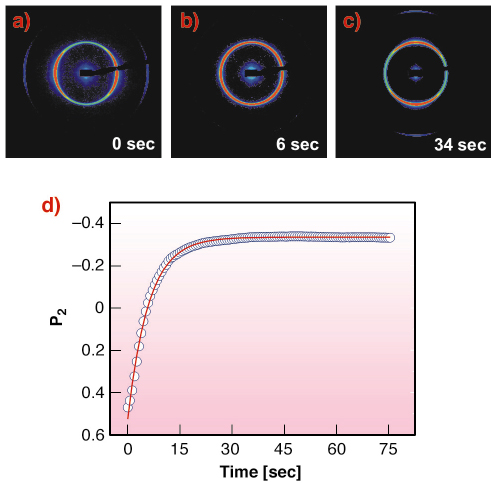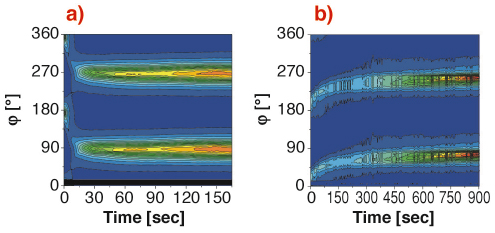- Home
- Users & Science
- Scientific Documentation
- ESRF Highlights
- ESRF Highlights 2005
- Soft Condensed Matter
- Kinetics and Mechanisms of Electric Field Induced Alignment of Block Copolymer Solutions
Kinetics and Mechanisms of Electric Field Induced Alignment of Block Copolymer Solutions
The microphase separation of block copolymers has been studied extensively over the past two decades both experimentally and theoretically. In the ordered state, these materials exhibit highly regular mesoscopic microdomain structures with characteristic length scales of the order of several tens of nanometres. Similar to polycrystalline materials, typically small grains of microdomains are formed, the size of which may be of the order of micrometres. As a consequence, although a single grain may have a highly anisotropic structure (e.g. cylinders or lamellae), a bulk sample of a block copolymer typically exhibits isotropic materials properties. If macroscopic anisotropies are desirable, additional efforts have to be made to create macroscopic alignment of the microdomain structures. In the past, external mechanical fields have been successfully applied to orient block copolymer melts.
In addition to mechanical fields, the potential of electric fields for microdomain alignment has attracted increasing interest in the recent past as it may also be of considerable technical interest. It has been shown that - due to the differences in the dielectric constants (![]()
![]() ) of the blocks - both lamellar and cylindrical block copolymer microstructures orient parallel to the electric field vector when subjected to a DC electric field. Cylindrical microdomains can in principle be aligned along the field vector resulting in a single monodomain (i.e. a block copolymer “single crystal”). In a lamellar microdomain structure, on the other hand, all lamellar orientations containing the electric field vector within the lamellar planes are energetically equivalent.
) of the blocks - both lamellar and cylindrical block copolymer microstructures orient parallel to the electric field vector when subjected to a DC electric field. Cylindrical microdomains can in principle be aligned along the field vector resulting in a single monodomain (i.e. a block copolymer “single crystal”). In a lamellar microdomain structure, on the other hand, all lamellar orientations containing the electric field vector within the lamellar planes are energetically equivalent.
Melt-based electric field procedures suffer from severe limitations due to the high melt viscosities typical for high molecular weight copolymers or copolymers of more complex architectures and the chemical instability at high temperatures. In order to overcome these limitations, we used concentrated block copolymer solutions, where a non-selective solvent is employed to induce sufficient mobility and investigated the kinetics and mechanisms of the microdomain orientation under a DC electric field by time-resolved synchrotron small-angle X-ray scattering (SAXS). As a model system, we use a lamellar polystyrene-b-polyisoprene block copolymer (PS-b-PI) dissolved in toluene [1,2].
In order to quantify the orientation kinetics, the orientational order parameter P2 was calculated for each single scattering pattern acquired during the course of the experiment. The behaviour of P2 as a function of time t could be fitted by a single exponential as described by:
|
|
with P2,0 and P2,∞ being the limiting values of the order parameter before application of the electric field and at late times, respectively, and ![]() being the time constant (Figure 70).
being the time constant (Figure 70).
 |
|
Fig. 70: (a-c) SAXS patterns of a 35 wt.-% solution of the lamellar PS-b-PI diblock copolymer in toluene taken at room temperature prior (a) and after (b, c) application of an electric field (E = 1 kV/mm). (d) Time dependence of the orientational order parameter P2. The solid line is a least-squares fit to the data according to Equation 1 with P2,0 = 0.52, P2,∞ = –0.32, and |
In addition, from the azimuthal angular dependence of the scattering intensity, we could identify two different microscopic mechanisms:
Close to the order-disorder transition (weakly phase separated system), i.e. at low concentrations and high temperatures, microdomains aligned parallel to the electric field grow at the expense of those aligned parallel to the electrodes. Intermediate orientations, however, are not observed (Figures 70a-c and Figure 71a), but the isotropoic background scattering increases.
 |
|
Fig. 71: Azimuthal angular dependence of the scattering intensity for different concentrations at 1 kV/mm. (a) 35 wt.-%, (b) 50 wt.-%. |
Further away from the order-disorder transition (stronger phase separated system), i.e. for high concentrations and low temperatures, the scattering pattern seems to be preserved and merely shifts into the new orientation. This observation points to the rotation of entire grains as an alternative orientation process (Figure 71b). In contrast to the migration of grain boundaries, microdomain orientations intermediate between the original and the final orientations are observed. No increase in isotropic scattering is observed during the transition.
References
[1] A. Böker, A. Knoll, H. Elbs, V. Abetz, A.H.E. Müller, G. Krausch, Macromolecules, 35, 1319-1325 (2002).
[2] A. Böker, H. Elbs, H. Hänsel, A. Knoll, S. Ludwigs, H. Zettl, A.V. Zvelindovsky, G.J.A. Sevink, V. Urban, V. Abetz, A.H.E. Müller, G. Krausch, Macromolecules, 36, 8078-8087 (2003).
Principal Publication and Authors
A. Böker (a), K. Schmidt (a), G. Krausch (a), V. Urban (b), T.M. Weiss (b), Phys. Rev. Lett., 89, 135502 (2002).
(a) Physikalische Chemie II, Universität Bayreuth, Bayreuth (Germany)
(b) ESRF, ID02



